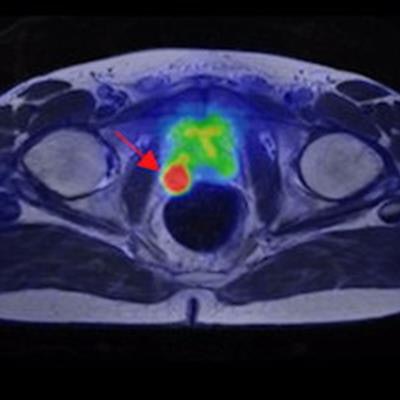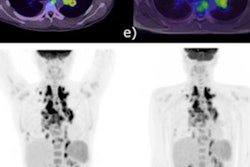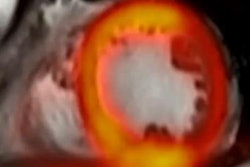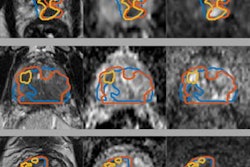
The use of PET/MRI with a dual-tracer approach can enhance staging of high-risk prostate cancer patients by providing extra information and improving disease characterization, Italian investigators have reported.
"Molecular imaging is another valid imaging approach in prostate cancer staging, with new PET tracers bearing potential to improve diagnosis, staging and follow-up," noted Paola Scifo, PhD, from the Department of Nuclear Medicine, IRCCS San Raffaele Scientific Institute, Milan, and colleagues. "Hybrid PET/MRI allows the simultaneous acquisition of metabolic, structural, and functional imaging information concerning prostate cancer status in a whole-body, single session examination."
PET/MRI is an innovative approach to stage prostate cancer, and the combined use of both gallium-68 (Ga-68) prostate-specific membrane antigen (PSMA) and Ga-68 DOTA-RM2 radiotracers can improve disease staging by providing different metabolic aspects of the tumor, they reported in a poster at the annual meeting of the International Society for Magnetic Resonance in Medicine (ISMRM).
Added value of hybrid imaging
Histological confirmation is still required for the diagnosis of prostate cancer, but now multiparametric MRI is commonly implemented in clinical routine to detect the primary tumor, guide biopsies, and define the local extent of the disease. Against this background, the Milan group sought to investigate the synergistic role of Ga-68 PSMA PET, Ga-68 DOTA-RM2 PET, and MRI in prostate cancer staging using a hybrid PET/MRI scanner.
Thirteen patients (mean age, 66.7; standard deviation, 8.8) with biopsy-proven prostate cancer underwent Ga-68 PSMA PET/MRI and Ga-68 DOTA-RM2 PET/MRI in two different days for staging purposes. The patients were scanned on a Signa PET/MRI system (GE Healthcare).
Radical prostatectomy was then performed. The PSMA protocol consisted of a high statistic (HS) pelvic PSMA-PET scan, during which T2-weighted, diffusion-weighted imaging (DWI), and dynamic contrast-enhanced sequences were acquired, as well as a total body PET acquisition with LAVA-Flex and DWI on each scan.
The Ga-68 DOTA-RM2 protocol consisted of an HS pelvic Ga-68 DOTA-RM2 PET scan during which a T2 sequence was acquired, along with total-body PET acquisition with LAVA-Flex.
TNM classification based on image findings was performed and quantitative imaging parameters were collected for each scan. Specifically, on the pelvic HS PET scans, the volumes of interest (VOIs) on the tumor lesions were segmented on the Ga-68 PSMA PET, Ga-68 DOTA-RM2 PET, and on T2-weighted MR images by an expert nuclear medicine physician and an expert radiologist.
After having coregistered PSMA and DOTA-RM2 studies, the researchers calculated the Dice coefficient between the VOIs. Furthermore, the histological data derived from prostatectomy were used as gold standard to validate intraprostatic findings as well as local extension of the disease.
 Example of an intraprostatic concordant finding in a 53-year-old patient who underwent dual-tracer PET/MRI for prostate cancer staging. (A) Transaxial Ga-68 PSMA PET. (B) Ga-68 PSMA PET/MRI. (C) Axial T2-weighted sequence. (D) Diffusion-weighted imaging (b = 1,400) of the prostate. (E) Transaxial Ga-68 DOTA-RM2 PET. (F) Ga-68 DOTA-RM2 PET/MRI. (G) Axial T2-weighted sequence. Red arrows indicate pathological prostate findings. Courtesy of Paola Scifo, PhD, and ISMRM.
Example of an intraprostatic concordant finding in a 53-year-old patient who underwent dual-tracer PET/MRI for prostate cancer staging. (A) Transaxial Ga-68 PSMA PET. (B) Ga-68 PSMA PET/MRI. (C) Axial T2-weighted sequence. (D) Diffusion-weighted imaging (b = 1,400) of the prostate. (E) Transaxial Ga-68 DOTA-RM2 PET. (F) Ga-68 DOTA-RM2 PET/MRI. (G) Axial T2-weighted sequence. Red arrows indicate pathological prostate findings. Courtesy of Paola Scifo, PhD, and ISMRM.In the figure above, the analysis of semiquantitative parameters of prostate uptake extracted from HS Ga-68 PSMA images showed a mean SUVmax of 19.2 (standard deviation [sd], 10.9); SUVmean 40%-50%-60% of 11.6, 12.9, and 14.6, respectively (sd, 6.8, 7.6, 8.4, respectively), metabolic tumor volume (MTV) 40%-50%-60% of 1.6, 1.1, and 0.7, respectively (sd, 0.9, 0.8, 0.7, respectively). In this 53-year-old patient, the analysis of semiquantitative parameters of prostate uptake extracted from HS Ga-68 DOTA-RM2 images showed a mean SUVmax of 15.3 (sd: 7.8); SUVmean 40%-50%-60% of 9.7, 10.8, and 11.5, respectively (sd, 5.2, 5.7, 6.0, respectively); MTV 40%-50%-60% of 2.9, 2.1, and 1.7, respectively (sd: 1.7, 1.4, 1.3 respectively).
Finally, the mean apparent diffusion coefficient (ADCmean) and minimum ADC (ADCmin) were measured for each patient using the corresponding VOIs defined on the T2 images. The mean ADCmean value of the primary tumors was 0.8 10-3 mm2/s (sd: 0.1), while mean ADCmin value was 0.5 10-3 mm2/s (sd, 0.15) and mean lesion volume was 1.7 cm3 (sd: 1.1).
Other key findings
Scifo and colleagues reported that all imaging modalities detected the primary intraprostatic lesion, being in agreement on the intraprostatic site of disease in 12 out of 13 cases; in one patient, Ga-68 PSMA PET identified the primary tumor in the left side of the prostate, while Ga-68 DOTA-RM2 PET and MRI were concordant with histology in identifying the primary tumor on the right lobe.
On seminal vesicle invasion (SVI), in 11 out of 13 patients Ga-68 PSMA, Ga-68 DOTA-RM2 PET, and MRI did not detect any involvement, being concordant with histology; in two patients, histology identified SVI not seen on imaging. The validation of extracapsular extension (ECE) with histology was performed only for MRI, as both Ga-68 PSMA and Ga-68 DOTA-RM2 PET are not suitable to identify ECE because of their limited spatial resolution.
Histology and MRI were concordant in five out of 13 patients (2/13 positive and 3/13 negative for ECE) and discordant in eight out of 13 (5/13 with ECE at histology but not on MRI, and 3/13 positive on MRI but not confirmed at histology).
"These preliminary results suggest the potential complementary role of Ga-68 PSMA PET, Ga-68 DOTA-RM2 PET and MRI in prostate cancer characterization during the staging phase," Scifo told ISMRM 2022 delegates. "A very innovative aspect of the present study relies on the use of PET/MRI scanner for both Ga-68 PSMA and Ga-68 DOTA-RM2, differently from the few published studies on this topic."
The multitracer approach offers the possibility to identify different sites of disease, thus improving disease characterization and therefore patients' management and follow-up, she concluded, adding that the research was funded by the Italian Association for Cancer Research and by the Italian Ministry of Health.



















